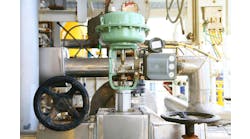Greg McMillan and Stan Weiner bring their wits and more than 66 years of process control experience to bear on your questions, comments and problems. Write to them at [email protected].
Greg: We had a shortage of talent to take advantage of the emerging capability. When the vice president of Monsanto research introduced me to Alex Muravyev, a senior associate at Kiev Polytechnical Institute Laboratory of Chemical Cybernetics, I took advantage of the opportunity and helped Alex get a job as a consultant at a key contractor. One of his many accomplishments at the Institute in Kiev was the implementation of optimal control of coke gas separation units by thermodynamic optimization of available energy, a universal criterion and environmentally responsible approach that does not depend upon the costs of utilities.
In his first major project at Monsanto, Alex used his knowledge of polymerization kinetics to provide models for operator training at a grass-roots plant in Thailand for ABS plastic. Subsequently, he developed a model of a plant gas system with incredibly large and fast bursts of gas generation to study and demonstrate the transition to a process with a thermal oxidizer. Alex is now a principal in R&D at Mynah Technologies, LLC (www.mynah.com).
Stan: What is the future of operator training systems, and what are you doing to further simulation technologies?
Alex: The companies that have a culture of modeling and model-based control are demanding higher fidelity models that can be used for operators to learn, not just how to use the control system, but also how to deal with abnormal process conditions and operate the process more efficiently. To meet this need, I am creating advanced modeling objects that are programmed into efficient C++ code that can run in real time on a user PC. We created the column and separator as advanced modeling objects, along with a physical property database and enthalpies and vapor liquid equilibrium (VLE) thermodynamics package.
The first application of the object, database and thermo package were distillation columns for a de-ethanizer, debutanizer and stripper in a new hydrocracker unit. The models provided closed-loop testing of various control strategies and showed the occurrence of undesirable events, such as "heat shock" in the reboiler. The plant used the simulation to avoid shutdowns from hidden issues in the control strategies. The upsets simulated included reaction runaway due to feed disruption or malfunction of reactor quench valves, recovery of the unit after runaway and depressurizing of the system, and sudden changes in feed composition.
Greg: The operators live with the process day and night and are a largely underutilized resource for sustainable manufacturing. There is a growing recognition that advanced modeling objects with deep first principles and thermodynamics can be used in a building blocks approach to gain knowledge. What do you see as some of the future potential uses of the separator block?
Alex: We are finding an increasing diversity of applications. The separator block can be used for evaporators and for reactors with gases and liquids (mixed phases) by the addition of kinetics. For acid-base reactions and neutralizations with mixed phases, a charge balance can be added to the separator. For reactive distillations, the kinetics can be added to each tray.
Stan: What if the plant is mostly into basic control and is not ready to venture into high-fidelity modeling?
Alex: The skeleton is auto-generated for basic modeling objects to provide the first-order-plus-dead-time models. Special relationships between inputs and outputs for their process are easily added. When the plant operators are ready to advance their knowledge of the process, advanced objects can be added to work seamlessly with the basic objects. The pressure-flow solver designed to work with advanced objects also has a flexible boundary, so the user can focus on the areas where the pressure drops, and flows in piping, valves and sparger are particularly important.
Greg: What is missing today in most processes is knowledge of the best operating points. A loop is only as good as its setpoint (http://modelingandcontrol.com/2011/07/top-ten-limitations-%e2%80%93-setpoints/). A good dynamic model can allow the user to explore the benefit of simply changing the setpoint. The dynamic model can also provide an inferential measurement.
At Monsanto-Solutia, a high-fidelity model was used to provide a fast, noise-free, online measurement of excess reactant in gas reactors. The inferential measurement provided a closed-loop adjustment of reactants that paid for itself in less than a year by an increase in yield. Traditionally, steady-state simulations have been used for real-time optimization of continuous processes. How do you see dynamic simulations moving into this role?
Alex: The extensive knowledge of parameters in steady-state simulations used for continuous process design and optimization can be directly transported to dynamic simulations. The equations in steady-state simulations simply have the derivatives for the accumulation of mass, energy, charge or momentum equal to zero. In dynamic simulations, the accumulations are allowed to change, enabling the modeling of abnormal situations, start-ups, transitions, upsets and batch operations. Dynamic models can be used to compute an optimum sequence of setpoints and control actions. Eighty percent of advanced control is a good dynamic process model.
Stan: What do you see as the best future technology?
Alex: The "gray box" model offers the greatest future promise where the key coefficients of first-principle dynamic models are adapted online. This combination makes the model valid in a much wider range of process conditions than a purely empirical "black box" model, even if the black box model had the "correct" sets of inputs and outputs (i.e., internally non-correlated). The changes in parameters are updated process knowledge that can be used to monitor changes in the raw materials, process, and equipment.
Greg: The identification of dead time can lead to the identification of factors that are the source of delays and small lags that become effectively dead time in the observed response. The ramp rate over the next two to four dead times can provide an integrating or "near-integrating" process gain that is a function of key process parameters. The dead time and process gain can be routinely identified for setpoint changes to estimate parameters. Model-based controllers or enhanced PID valve position controllers also can be used to provide closer agreement of corresponding manipulated variables between the actual plant and a real-time virtual plant by adapting key model parameters.
Stan: How would you succinctly summarize our opportunity?
Alex: We have feedback control systems because processes are dynamic. There is a synergy between process control and dynamic modeling. Advanced control incorporates dynamic process knowledge for reducing energy, raw materials, recycle and waste, preserving resources and the environment while increasing process efficiency and capacity. In other words, dynamic models are the crucial first step for sustainable manufacturing.
Greg: One thing I don't miss as a contractor is performance reviews and team building exercises. Here's why:
Top 10 Things You Don't Want to Hear in Your Performance Review
(10) I see you refused to be a sumo wrestler in our team building exercise.
(9) What have you done lately to get me promoted?
(8) Do you have an evil twin?
(7) Can you be replaced by the "cloud?"
(6) You are at the top; the only way is down.
(5) Have you thought about another career?
(4) Pick a number from one to 10.
(3) Boy, you are ancient.
(2) What is all this jibber jabber about tuning and loop performance?
(1) Who are you?





